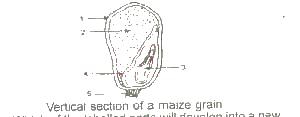A) Renal vain
B) Renal artery
C) Hepatic artery
D) Hepatic portal vein
E) Coelic artery
Show Answer
The correct answer is D .
Which of the following statements is true regarding sex-linked traits?
Options:A) Sex-linked traits are located on the sex chromosomes
B) Sex-linked traits are inherited only from the mother
C) Sex-linked traits are more commonly observed in females
D) Sex-linked traits are not influenced by hormonal factors
Show Answer
The correct answer is A .

The structure labelled 1 is the
Options:A) plumule
B) radicle
C) cell membrane
D) seed coat
Show Answer
The correct answer is D .
A) Lapping and sponging
B) Sucking and chewing
C) Piercing and sucking
D) Chewing and lapping
E) Biting and chewing
Show Answer
The correct answer is A .
Blood circulation in a mammal is said to be double because?
Options:A) it passes twice through the heart in a complete circuit
B) it moves in both arteries and veins
C) it circulates in both the heart and other organs
D) the heart contains auricles and ventricles
Show Answer
The correct answer is A .
A) duck
B) owl
C) weaver bird
D) hawk
Show Answer
The correct answer is C .
A) Reptiles
B) Fish
C) Amphibians
D) Birds
Show Answer
The correct answer is C .
The following processes are involved during expiration in man except
Options:A) The inter costal muscles relax
B) The thoracic activity first increases in volume
C) The sternum moves inward
D) The ribs are moved downwards and inwards
Show Answer
The correct answer is B .
A) anaesmia
B) anorexia
C) haemophilia
D) haemolysis
Show Answer
The correct answer is C .
A) skeleton
B) ligament
C) muscle
D) joint
Show Answer
The correct answer is A .